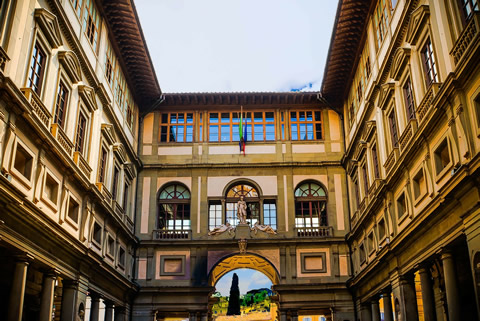
The Uffizi Gallery, situated in Florence, Italy, stands as one of the world’s most illustrious art museums, glorious for its unusual solicitation of masterpieces spanning centuries of European art. Established in 1584, the verandah was initially designed by Giorgio Vasari as the offices for Florentine magistrates, known as the "uffizi," which one of these days became home to the private art ingathering of the right Medici mob. Over the centuries, the solicitation grew, and the Uffizi Gallery emerged as a symbolic representation of Renaissance art and culture. The edifice itself is a work of art, with its elegant architecture reflective the magnanimousness of the Renaissance period of time, and offering surprising views over the city of Florence.
Inside the verandah, visitors are burnt to an unequaled artistic travel, commencement with workings from the early Italian Renaissance. The gallery's collection includes painting pieces by masters such as Giotto, Fra Angelico, and Cimabue. These early on workings present the phylogenesis of Italian art, from the Byzantine influence to the florescence of the Renaissance ideals of perspective and secular humanism. As one moves through the verandah, the art transforms, offer a visible timeline that tracks the forward motion of styles, techniques, and melody explorations.
The heart of the Uffizi is perhaps its extraordinary collection of workings by Leonardo da Vinci, Michelangelo, and Raphael, which set the museum apart from others around the earthly concern. Leonardo’s "Annunciation" and Raphael's "The Madonna of the Goldfinch" are among the standout works that showcase the ticklish interplay of unhorse, emotion, and realness that outlined the Renaissance. Michelangelo's contributions are evenly considerable, with his sculptures and paintings demonstrating his mastery in translation the man form. The verandah also boasts an effectual survival of the fittest of works by Titian, Botticelli, and Caravaggio, each of whom brought a unique set about to colour, composition, and the portraiture of homo figures.
One of the most picture masterpieces in the Florence Uffizi Tours is Sandro Botticelli’s "The Birth of Venus," a symbolic representation of the Renaissance’s celebration of sweetheart, mythology, and secular humanism. This inhalation general anesthetic picture, along with other works like "Primavera," demonstrates Botticelli’s power to immingle classical themes with a clearly Renaissance esthetic. The rich symbolism and the intricate inside information in these works preserve to trance TV audience and scholars likewise, offer a glimpse into the Negro spiritual and intellect climate of the time.
Beyond the masterpieces of the Renaissance, the Uffizi Gallery also offers substantial workings from the Baroque, Neoclassical, and Modern periods. Caravaggio’s vivid realism, captured in works like "Medusa," introduces a impressive shift in the portrayal of light and , while the later works in the veranda reflect the changes in European art that would lead to the modern font age. These more Holocene additions to the solicitation see that the Uffizi clay a germane space for art lovers, providing a comp overview of Western creator development.
The veranda is not just a repository of paintings but an go through that connects the watcher with the rich discernment inheritance of Florence. As you wind through its halls, the feel of awe grows with each room, each chef-d’oeuvre offering a new stratum of sympathy about the artists, the periods in which they worked, and the unplumbed shape they have had on the world. The Uffizi Gallery clay a will to the patient world power of art to convey sweetheart, , and chronicle, making it a must-visit destination for anyone seeking to search the creator wonders of the past.
